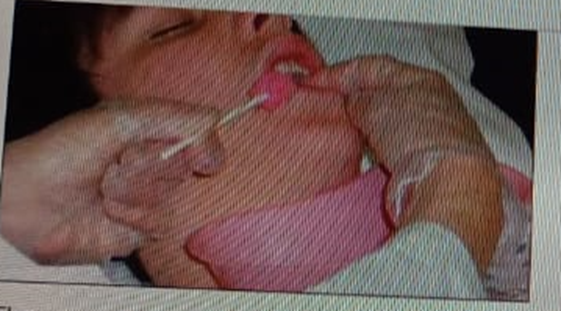The nurse observes an unlicensed assistive personnel (UAP) begin to provide oral care to an unresponsive client who is at risk for aspiration as seen in the picture. Which instruction(s) should the nurse provide the UAP? Select all that apply.

Remove the gloved finger from the mouth.
Flex the client's neck forward.
Apply lubricant to the tootherte
Turn the client's head to the side.
Elevate the head of the bed to semi-Fowler's
Correct Answer : B,D,E
A. Removing the gloved finger from the mouth is not necessarily appropriate unless the UAP is at risk of injury or if the client has a gag reflex that is causing a problem.
B. Flex the client's neck forward helps facilitate drainage and reduces the risk of aspiration while providing oral care.
C. Applying lubricant to the toothettes is not a priority in this scenario and may not be necessary.
D. Turn the client's head to the side is an important safety measure to prevent aspiration of saliva or oral care products.
E. Elevate the head of the bed to semi-Fowler's helps reduce the risk of aspiration by allowing gravity to assist in the drainage of fluids and secretions.
Nursing Test Bank
Naxlex Comprehensive Predictor Exams
Related Questions
Correct Answer is B
Explanation
A: Assistive feeding devices may help, but they do not directly address the risk of aspiration. Improving swallowing mechanics is more immediately beneficial.
B: The tucked-chin position helps protect the airway by improving swallowing coordination and reducing the risk of aspiration during meals. It is a simple technique that can significantly help clients with swallowing difficulties.
C: Lying down can increase the risk of aspiration by allowing food to enter the airway more easily.
D: Supplemental liquid feedings may be necessary for some ALS patients, but addressing the client’s swallowing technique during meals should take priority to prevent aspiration.
Correct Answer is D
Explanation
A: Identifying effective pain relief measures is important but comes after determining the pain's characteristics. Without knowing the pain's quality, choosing the best pain relief strategy is challenging.
B: Observing body language and movement is valuable, but it does not provide specific details about the type of pain the client is experiencing.
C: A numeric pain scale measures the intensity of pain but does not assess the quality, which is important in cancer-related pain management.
D: Asking the client to describe the pain provides essential information about the quality (sharp, dull, throbbing, burning) and nature of the pain, allowing the nurse to better tailor pain management strategies.
Whether you are a student looking to ace your exams or a practicing nurse seeking to enhance your expertise , our nursing education contents will empower you with the confidence and competence to make a difference in the lives of patients and become a respected leader in the healthcare field.
Visit Naxlex, invest in your future and unlock endless possibilities with our unparalleled nursing education contents today
Report Wrong Answer on the Current Question
Do you disagree with the answer? If yes, what is your expected answer? Explain.
Kindly be descriptive with the issue you are facing.
